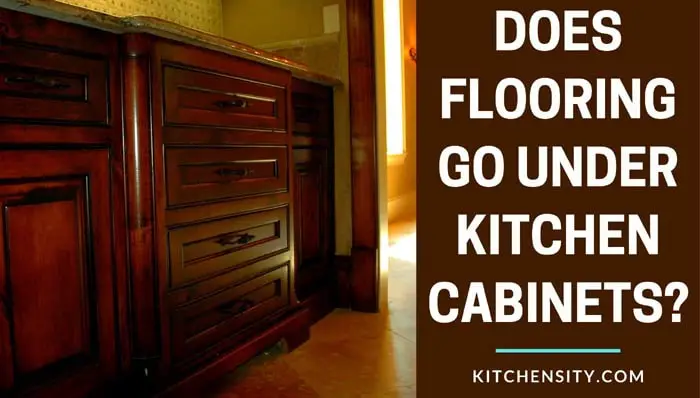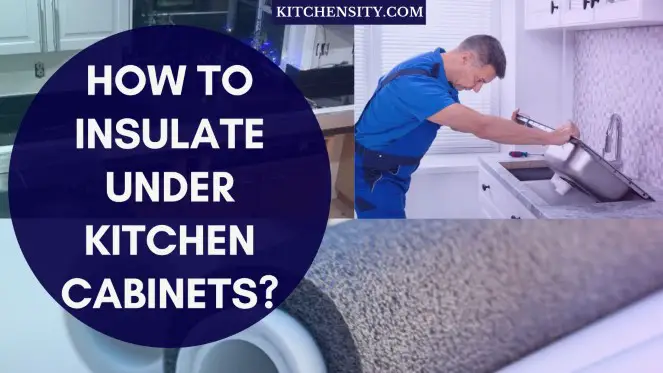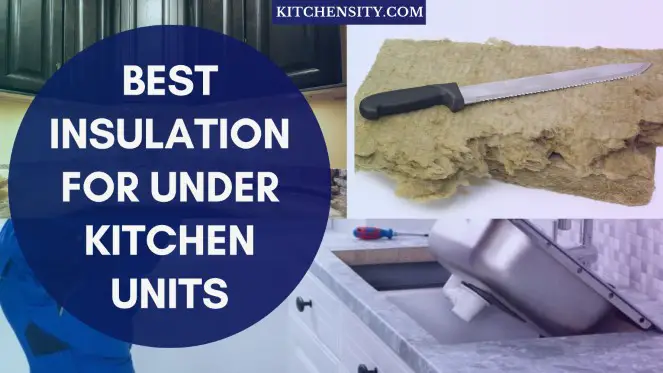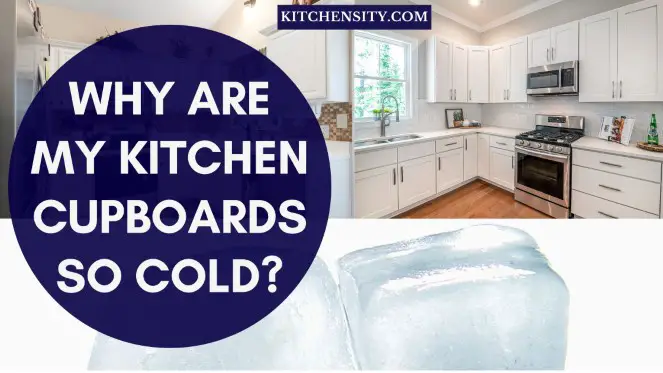Loft insulation helps to slow down the transfer of heat between your home and the outside environment.
It is mainly installed on the roof or floor to prevent heat transfer and make your home warmer in winter and cooler in the summer.
Before we dive into whether loft insulation can be used under kitchen cabinets, it’s important to understand what loft insulation is and how it works.
Loft insulation is typically made from materials such as glass wool, mineral wool, or cellulose fiber, and is designed to prevent heat from escaping through the roof of a home.
By installing loft insulation, homeowners can significantly reduce their energy bills and make their homes more comfortable.
Now comes the question:
Table of Contents
- 1 Can You Use Loft Insulation Under Kitchen Cabinets?
- 2 Where Are Your Kitchen Cabinets Installed?
- 3 How To Install Loft Insulation Under The Cabinets?
- 4 Why Use Loft Insulation Under Kitchen Cabinets?
- 5 Pros And Cons Of Using Loft Insulation Under Kitchen Cabinets
- 6 Precautions To Take
- 7 Can You Use Loft Insulation In Other Areas of the Kitchen?
- 8 Other Types Of Insulation To Consider For The Kitchen
- 9 What Is The Importance Of Proper Insulation In The Home?
- 10 Final Thoughts: Can You Use Loft Insulation Under Kitchen Cabinets?
- 11 FAQ’s (Frequently Asked Questions)
- 11.1 Is Installing Loft Insulation Under Kitchen Cabinets Will Heat The Appliances?
- 11.2 How Do I Fill The Gaps Under My Kitchen Cabinets?
- 11.3 How Do I Insulate Under My Kitchen Sink?
- 11.4 Should I Insulate My Kitchen?
- 11.5 Can You Insulate A Kitchen Ceiling?
- 11.6 Why Are My Kitchen Cabinets So Cold?
- 11.7 Is It Safe to Install Loft Insulation Under Kitchen Cabinets?
- 11.8 Will Loft Insulation Affect the Performance of Under-cabinet Lighting?
- 11.9 How Much Loft Insulation Do I Need for My Kitchen?
Can You Use Loft Insulation Under Kitchen Cabinets?
Yes, you can use loft insulation under kitchen cabinets, but keep some small vents available for the appliances attached to the cabinets. In this way, your kitchen’s temperature will not fluctuate and will maintain an adequate temperature, and also, the large appliances will not get hot due to the vents.
Before installing the insulation, check out these conditions.
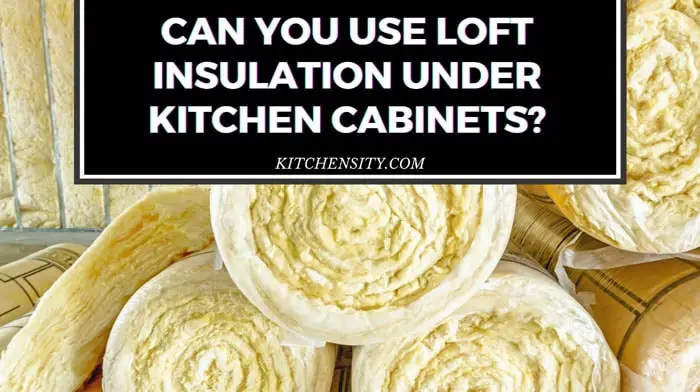
Also Read – How To Insulate Behind Kitchen Cabinets?
Where Are Your Kitchen Cabinets Installed?
The position of the cabinets plays an essential role in maintaining the temperature inside the cabinets.
If your cabinets are installed on the interior walls, then insulating them will be fine, and you can control the temperature to some extent.
However, if installed on the exterior walls, only insulating the cabinets will not work because the heat can quickly transfer through the walls to the cabinets, and your insulation will be wasted.
So, first, check out the position of your cabinets, and depending on that, you have to make the decision.
What To Do If My Cabinets Are Installed On The Exterior Walls?
If your cabinets are installed on exterior walls, a recommended solution is to prioritize insulating the walls. Insulating the walls effectively slows down the heat transfer, resulting in a warmer kitchen environment.
For optimal insulation, consider using foam injection, a superior alternative to loft insulation. Foam injection fills cavities, such as cracks and gaps, providing efficient insulation that doesn’t sag, settle, or compress over time. This method helps maintain a consistent temperature and can contribute to lower energy bills.
Additionally, spray foam insulation is another effective option, surpassing the efficiency of traditional fiberglass and cellulose insulation. The primary goal is to keep your kitchen warm, preventing your food from cooling rapidly.
Also Read – How to Insulate Under Kitchen Sink?
How To Install Loft Insulation Under The Cabinets?
Installing loft insulation under your cabinets is a straightforward process that can significantly contribute to maintaining a warmer kitchen environment. Here’s a step-by-step guide:
- Assess And Measure:
- Measure the area under the cabinets to determine the amount of insulation needed.
- Take note of any gaps or spaces where cold air may be infiltrating.
- Choose Suitable Insulation: Select a suitable insulation material that is safe for kitchen use and poses no fire hazard.
- Cut Insulation To Size: Using a sharp knife or scissors cut the insulation to the appropriate size based on your measurements.
- Place Insulation Under Cabinets:
- Lay the insulation underneath the cabinets, ensuring there are no gaps or spaces between the insulation and the floor.
- Fill any noticeable gaps with loft insulation.
- Secure In Place: Use adhesive tape or another suitable material to secure the insulation in its place, preventing any shifting.
- Address Small Gaps With Spray Foam:
- If you encounter tiny gaps that are difficult to insulate with loft insulation alone, use spray foam.
- Spray foam will fill small gaps effectively, enhancing the overall insulation under the cabinets.
- Cut Openings For Pipes Or Cables: If necessary, cut holes in the insulation to accommodate pipes or cables passing through the area.
- Cover With A Protective Layer:
- Once the insulation is in place, cover it with a protective layer, such as a sheet of plywood or a metal panel.
- This layer adds an extra barrier against heat transfer.
- Install Kitchen Cabinets: With the insulation securely in place, proceed to install the kitchen cabinets as you normally would.
Important Note: Insulating the area under the cabinets is a valuable step in preventing heat transfer, but for comprehensive insulation, it’s crucial to address the entire kitchen. Ensure there are no gaps left in any part of your kitchen, extending the insulation efforts to cover all potential areas where cold air could infiltrate.
Also Read – What Can I Put Under My Kitchen Sink to Protect My Cabinets?
Why Use Loft Insulation Under Kitchen Cabinets?
Using loft insulation under kitchen cabinets serves as an effective strategy to enhance energy efficiency, temperature regulation, and overall comfort in your kitchen. Here are several reasons why loft insulation is beneficial in this specific context:
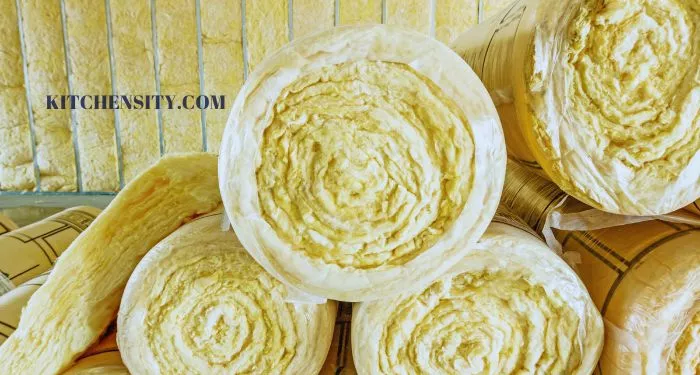
- Temperature Control: Loft insulation acts as a barrier against temperature fluctuations. By installing insulation under kitchen cabinets, you can help maintain a more stable and comfortable temperature in the kitchen. This is particularly important in areas prone to temperature extremes.
- Prevention Of Heat Loss: Kitchens often contain appliances that generate heat, such as ovens and stovetops. Loft insulation helps prevent heat loss by creating a thermal barrier. This ensures that the heat generated within the kitchen is retained, contributing to energy savings and a more consistently warm environment.
- Energy Efficiency: Insulating the space under kitchen cabinets contributes to the overall energy efficiency of your home. By reducing the need for constant heating or cooling to counteract temperature variations, loft insulation can help lower energy consumption and subsequently reduce utility bills.
- Minimization Of Cold Air Infiltration: Cold air can infiltrate a home through gaps, cracks, or spaces in the walls and floor. Loft insulation seals these gaps, preventing cold air from entering the kitchen space. This is especially relevant for kitchens situated on exterior walls, where external temperatures can impact indoor comfort.
- Improved Comfort: A well-insulated kitchen provides a more comfortable living environment. It helps eliminate cold spots and drafts, making the kitchen a more inviting and pleasant space for cooking, dining, and daily activities.
- Condensation Control: Insulation can help control condensation, which is crucial in kitchens where moisture levels can be high. By maintaining a consistent temperature, loft insulation minimizes the likelihood of condensation forming on surfaces, reducing the risk of mold and mildew growth.
- Comprehensive Home Insulation: Insulating the area under kitchen cabinets is part of a holistic approach to home insulation. When combined with insulation in other areas of the home, such as walls, ceilings, and floors, it creates a comprehensive thermal envelope that maximizes energy efficiency and comfort throughout the entire living space.
Also Read – How To Draft-Proof Your Under Kitchen Cabinets?
Pros And Cons Of Using Loft Insulation Under Kitchen Cabinets
PROS
There are several benefits to using loft insulation under kitchen cabinets, including:
- Temperature Control:
- Loft insulation acts as an effective barrier against temperature fluctuations, providing a more stable and comfortable environment in the kitchen.
- Particularly beneficial in areas prone to temperature extremes, ensuring year-round comfort.
- Prevention Of Heat Loss:
- Creates a thermal barrier that helps prevent heat loss in kitchens, where appliances like ovens and stovetops generate significant heat.
- Contributes to energy savings by retaining heat within the kitchen space, leading to a more consistently warm atmosphere.
- Energy Efficiency:
- Enhances the overall energy efficiency of the home by reducing the need for constant heating or cooling to counteract temperature variations.
- Subsequently lowers energy consumption and utility bills, promoting sustainable and cost-effective living.
- Minimization Of Cold Air Infiltration:
- Seals gaps, cracks, and spaces in walls and floors, preventing cold air from infiltrating the kitchen space.
- Particularly valuable for kitchens located on exterior walls, where external temperatures can impact indoor comfort.
- Improved Comfort:
- Creates a well-insulated kitchen environment that eliminates cold spots and drafts.
- Enhances overall comfort, making the kitchen a more inviting and pleasant space for various activities, including cooking and dining.
- Condensation Control:
- Helps control condensation in kitchens with high moisture levels by maintaining a consistent temperature.
- Reduces the likelihood of condensation forming on surfaces, mitigating the risk of mold and mildew growth.
- Comprehensive Home Insulation:
- Integrates with a holistic approach to home insulation, contributing to a comprehensive thermal envelope.
- When combined with insulation in other areas such as walls, ceilings, and floors, maximizes energy efficiency and comfort throughout the entire living space.
CONS
While there are many benefits to using loft insulation under kitchen cabinets, there are also some potential drawbacks to consider. These include:
- Installation Complexity:
- Installing loft insulation under cabinets may require careful measurements and cutting to fit the space properly.
- In some cases, professional installation may be necessary, adding to the overall cost.
- Limited Impact On External Factors:
- While effective for internal temperature regulation, loft insulation may have a limited impact on extreme external temperatures.
- External factors such as harsh weather conditions may still influence indoor comfort.
- Initial Cost:
- The initial cost of loft insulation materials and installation may be a consideration for homeowners.
- However, the long-term energy savings often outweigh the upfront expenses.
- Maintenance:
- Over time, insulation materials may require maintenance or replacement to ensure continued effectiveness.
- Regular checks and upkeep are essential to maximize the longevity of the insulation.
Also Read – How to Insulate Under Kitchen Cabinets?
Precautions To Take
To minimize the risk of fire or other hazards when using loft insulation under kitchen cabinets, you should take the following precautions:
- Avoid Blocking Air Vents:
- Ensure that loft insulation installation does not obstruct or block any existing air vents in the kitchen.
- Unobstructed air circulation is vital for maintaining proper ventilation and preventing potential issues related to moisture and air quality.
- Secure Insulation Away From Water Sources:
- Keep insulation materials away from direct contact with water sources, such as sinks or plumbing fixtures.
- Moisture can compromise the effectiveness of insulation and lead to mold or mildew issues.
- Check For Pest-Resistant Insulation:
- Consider using insulation materials that are resistant to pests, as the kitchen environment can attract rodents or insects.
- Pest-resistant insulation helps prevent infestations that may compromise the integrity of the insulation.
- Mind Structural Integrity:
- Assess the structural integrity of the cabinets and surrounding areas before installing insulation.
- Ensure that the cabinets can support the additional weight of insulation materials without compromising their stability.
- Seal Gaps Properly:
- Pay meticulous attention to sealing gaps and openings during the insulation process.
- Proper sealing prevents drafts and ensures that the insulation remains effective in controlling temperature and moisture.
- Consider Accessibility For Future Repairs:
- Plan the insulation installation in a way that allows for accessibility to pipes, cables, or other components that may require maintenance or repairs in the future.
- Accessibility facilitates easier inspections and repairs without compromising the insulation.
- Evaluate Compatibility With Cabinet Materials:
- Verify that the chosen insulation materials are compatible with the materials used in the construction of the cabinets.
- Some insulation materials may have specific compatibility requirements to avoid any adverse reactions with cabinet materials over time.
- Consult Building Codes And Regulations:
- Familiarize yourself with local building codes and regulations related to insulation installation.
- Adhering to codes ensures that the installation meets safety standards and regulations applicable in your region.
- Consider Long-Term Durability:
- Opt for insulation materials that offer long-term durability and resilience to ensure continued effectiveness over the years.
- Long-lasting insulation minimizes the need for frequent replacements or maintenance.
- Consult With A Professional:
- If uncertain or unfamiliar with insulation installation, consider consulting with a professional contractor or insulation specialist.
- Professionals can guide the most suitable materials and methods for your specific kitchen configuration.
Also Read – Best Insulation for Under Kitchen Units
Can You Use Loft Insulation In Other Areas of the Kitchen?
While loft insulation is typically designed for use in attics or lofts, it may not be the most suitable insulation material for all areas within the kitchen. However, there are specific types of insulation that are better suited for different parts of the kitchen. Here’s a breakdown:
- Walls: For exterior walls in the kitchen, consider using cavity wall insulation or rigid foam board insulation. These materials are designed to fit within the walls and provide effective thermal resistance.
- Ceilings: If you have a kitchen on the ground floor with a room above, using insulation in the ceiling can be beneficial. Fiberglass or mineral wool insulation is commonly used in ceilings.
- Under the Floor: Insulating the floor can help prevent heat loss and enhance comfort. Materials like rigid foam board insulation or fiberglass batts can be used beneath the kitchen floor.
- Around Appliances: When insulating areas around appliances, it’s crucial to consider fire safety. Use fire-resistant materials, such as rock wool or fiberglass, to minimize fire hazards.
- Pipes and Ducts: Insulate exposed pipes and ducts to prevent heat loss or gain. Pipe insulation, made from foam or fiberglass, is designed for this purpose.
- Windows and Doors: Use weather stripping or draft excluders around windows and doors to prevent drafts. Double-glazed windows and insulated doors are also effective in maintaining temperature.
- Ventilation: Ensure proper ventilation in the kitchen to control moisture. Ventilation solutions include exhaust fans, range hoods, and vents. Insulating ducts can also prevent condensation.
Always check the specific requirements and recommendations for each area of the kitchen. Insulation should be chosen based on factors such as the space available, the potential for moisture, and fire safety considerations. Also, local building codes and regulations should be consulted to ensure compliance with safety standards.
Also Read – Best Insulation Under The Kitchen Sink
Other Types Of Insulation To Consider For The Kitchen
In addition to loft insulation, there are several other types of insulation that you may want to consider for your kitchen, including:
- Cavity Wall Insulation: Ideal for exterior kitchen walls, cavity wall insulation involves filling the gap (cavity) between the inner and outer layers of the wall. This helps regulate temperature and prevent heat loss.
- Rigid Foam Board Insulation: Suitable for walls, ceilings, and floors, rigid foam boards provide excellent thermal resistance. They are easy to install and can be cut to fit specific spaces.
- Fiberglass Insulation: Commonly used in walls and ceilings, fiberglass insulation is versatile and effective. It comes in batts or rolls and is known for its affordability and fire resistance.
- Mineral Wool Insulation: Similar to fiberglass, mineral wool is fire-resistant and provides excellent thermal and sound insulation. It’s suitable for walls, ceilings, and around appliances.
- Spray Foam Insulation: Useful for sealing gaps and crevices, spray foam insulation expands to fill spaces. It’s effective for preventing air infiltration and is commonly used around windows, doors, and pipes.
- Reflective Foil Insulation: Reflective foil insulation is designed to reflect radiant heat. It’s often used in attics, but can also be applied in specific areas of the kitchen to prevent heat transfer.
- Insulating Concrete Forms (ICFs): ICFs are used in walls and provide both structural support and insulation. They consist of foam blocks or panels filled with concrete.
- Double-Glazed Windows: Upgrading to double-glazed windows with insulated glass can significantly reduce heat transfer through windows.
- Door Insulation: Insulated exterior doors help prevent drafts and maintain temperature. Look for doors with a high R-value for better insulation.
- Pipe Insulation: Insulating exposed pipes with foam or fiberglass insulation prevents heat loss or gain. This is particularly important for hot water pipes in the kitchen.
- Floor Insulation: Insulating the kitchen floor can contribute to energy efficiency. Consider materials like rigid foam board insulation or fiberglass batts.
- Draft Excluders And Weather Stripping: Use draft excluders around doors and windows, and apply weather stripping to seal gaps and prevent drafts.
Also Read – Why Are My Kitchen Cupboards So Cold?
What Is The Importance Of Proper Insulation In The Home?
Proper insulation in the home is crucial for several reasons, as it plays a fundamental role in enhancing comfort, energy efficiency, and overall well-being. Here are key reasons highlighting the importance of proper insulation:
- Temperature Regulation: Insulation helps regulate indoor temperatures by creating a barrier against heat transfer. In colder climates, it retains heat inside the home, while in warmer climates, it prevents excessive heat from entering, creating a more comfortable living environment year-round.
- Energy Efficiency: Well-insulated homes are more energy-efficient. By reducing heat loss or gain, insulation minimizes the need for constant heating or cooling, leading to lower energy consumption. This, in turn, contributes to reduced utility bills and a smaller environmental footprint.
- Cost Savings: Proper insulation can result in significant cost savings over time. The initial investment in quality insulation is often outweighed by the long-term reduction in energy bills, making it a financially sound decision for homeowners.
- Comfort And Livability: Insulation enhances overall comfort by eliminating drafts, cold spots, and excessive heat. It creates a consistent and comfortable indoor environment for residents, ensuring a more pleasant living experience.
- Moisture Control: Insulation helps control moisture levels within the home. By preventing condensation and humidity buildup, it reduces the risk of mold and mildew growth, which can be detrimental to both the structural integrity of the home and the health of its occupants.
- Noise Reduction: Insulation acts as a sound barrier, reducing the transmission of noise between rooms and from the outside environment. This is particularly important for maintaining a peaceful and quiet living space.
- Increased Property Value: Homes with proper insulation are often more attractive to potential buyers. Energy-efficient features, including insulation, contribute to a higher property value and may make the home more marketable.
- Environmental Impact: Energy-efficient homes with proper insulation contribute to a reduction in greenhouse gas emissions. Lower energy consumption means fewer resources are required for heating and cooling, promoting a more sustainable and environmentally friendly lifestyle.
- Long-Term Durability: Insulation helps protect the structural integrity of the home by minimizing temperature-related stresses. It can prevent issues such as warping, expansion, and contraction of materials, contributing to the long-term durability of the building.
- Compliance With Building Codes: Proper insulation is often a requirement of building codes and standards. Ensuring compliance with these regulations not only ensures the safety and well-being of occupants but also avoids potential legal issues related to home construction and maintenance.
So, proper insulation is essential for creating a comfortable, energy-efficient, and sustainable home. It addresses key aspects of indoor living, from temperature control and cost savings to environmental impact and long-term durability. Investing in quality insulation is a wise decision that benefits both homeowners and the environment.
Also Read – How To Stop A Draught From Behind Kitchen Cupboards?
Final Thoughts: Can You Use Loft Insulation Under Kitchen Cabinets?
So, utilizing loft insulation under kitchen cabinets proves to be a practical solution for preventing excessive heat transfer and maintaining optimal temperatures within the cabinet space. By carefully measuring and cutting loft insulation to fit the gaps, you can effectively create a thermal barrier that minimizes the impact of external temperatures.
For smaller or harder-to-reach areas, the application of spray foam provides a precise and efficient solution, ensuring that even the tiniest gaps are adequately sealed. Also, addressing the area under the kitchen sink by using Rockwool-filled grocery bags further contributes to comprehensive insulation.
Implementing these insulation measures serves as a proactive approach to controlling heat transfer, resulting in cabinets that resist rapid cooling. By following these steps, you can enhance both the functionality and longevity of your kitchen cabinets, creating a more comfortable and energy-efficient living space.
Also Read – How To Fix Scratched Kitchen Cabinets?
FAQ’s (Frequently Asked Questions)
-
Is Installing Loft Insulation Under Kitchen Cabinets Will Heat The Appliances?
It will not heat the appliances if they have proper ventilation. So, when you are insulating the cabinets, don’t forget to leave some spaces for proper ventilation near the large appliances.
If the large appliances are installed separately, then no need to worry about the ventilation as they will have enough space for ventilation. -
How Do I Fill The Gaps Under My Kitchen Cabinets?
Depending upon the size of the gaps, you have to insulate them. If the gaps are 2-4 inches, you can install the loft insulation, but you have to seal them with spray foam if they are very tiny.
-
How Do I Insulate Under My Kitchen Sink?
You can insulate the kitchen sink area with Rockwool, or you can use loft insulation. The easiest method is to take some grocery bags fill them with Rockwool and put the bags under your kitchen sink.
Try to fill all the areas with the bags, and for the pipes, you can use self-seal rubber insulation or polyethylene foam to insulate them properly. -
Should I Insulate My Kitchen?
Yes, for proper insulation, you have to insulate the kitchen.
If you only seal the cabinets, you will not find any significant difference in heat transfer, but it will have a substantial effect if you insulate the entire kitchen.
The cost will be more, but it will remain there for decades. -
Can You Insulate A Kitchen Ceiling?
Yes, you can insulate a kitchen ceiling. Insulating the ceiling will stop the heat transfer, and your kitchen will be much warmer. Along with the ceiling, you can insulate your floor for better results.
-
Why Are My Kitchen Cabinets So Cold?
For most kitchen cabinets to become cold, they are installed on the exterior walls where heat transfer is significant. There are two options to prevent this: insulating the cabinets and two insulating the walls.
The heat transfer will be lower if you do both, and your kitchen cabinets will not be cold. -
Is It Safe to Install Loft Insulation Under Kitchen Cabinets?
Yes, it is safe to install loft insulation under kitchen cabinets as long as proper precautions are taken.
You should ensure that the insulation is not in contact with hot appliances or electrical wiring and should use fire-resistant insulation materials. -
Will Loft Insulation Affect the Performance of Under-cabinet Lighting?
No, loft insulation should not affect the performance of under-cabinet lighting. However, it is important to ensure that the insulation is not blocking any wiring or electrical components.
-
How Much Loft Insulation Do I Need for My Kitchen?
The amount of loft insulation needed for a kitchen will depend on the size of the kitchen and the level of insulation required.
It is recommended to consult with a professional insulation contractor to determine the appropriate amount of insulation for your home.
Katrina Smith is a seasoned expert with over 25 years of experience in all things related to cooking and the kitchen. As an avid cook and kitchen enthusiast, she is passionate about sharing her knowledge and expertise on cookware, kitchen appliances, kitchen tips, and kitchen staples.
Through her articles and reviews, Katrina aims to inspire and help others improve their cooking skills, experiment with different ingredients, and invest in quality cookware and appliances.

![3 Effective Ways To Update Old Kitchen Cabinets [Under $100] 4 How To Update Old Kitche Cabinets](https://www.kitchensity.com/wp-content/uploads/2021/05/How-To-Update-Old-Kitche-Cabinets.jpg)
![Refacing Kitchen Cabinets: An Ultimate DIY Guide [2023] 5 Refacing Kitchen Cabinets](https://www.kitchensity.com/wp-content/uploads/2021/05/Refacing-Kitchen-Cabinets.jpg)
